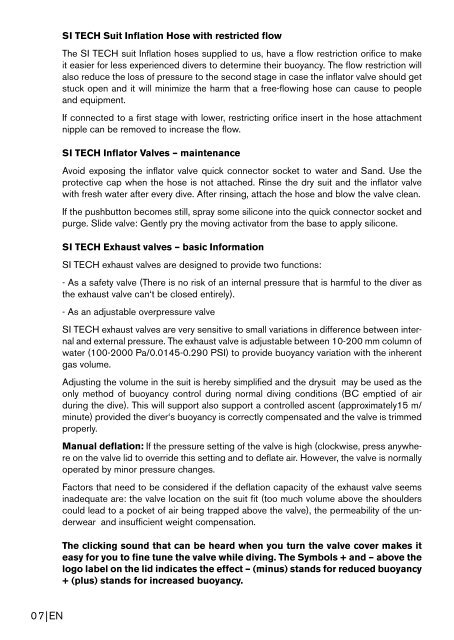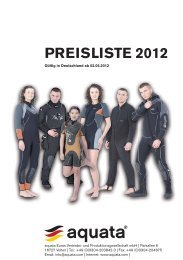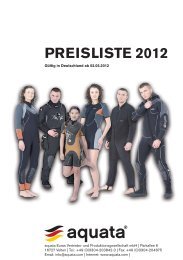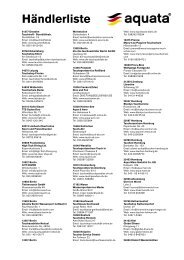GEBRAUCHS- UND PFLEGE- ANWEISUNG FÜR TROCKEN - Aquata
GEBRAUCHS- UND PFLEGE- ANWEISUNG FÜR TROCKEN - Aquata
GEBRAUCHS- UND PFLEGE- ANWEISUNG FÜR TROCKEN - Aquata
You also want an ePaper? Increase the reach of your titles
YUMPU automatically turns print PDFs into web optimized ePapers that Google loves.
07|EN<br />
SI TECH Suit Inflation Hose with restricted flow<br />
The SI TECH suit Inflation hoses supplied to us, have a flow restriction orifice to make<br />
it easier for less experienced divers to determine their buoyancy. The flow restriction will<br />
also reduce the loss of pressure to the second stage in case the inflator valve should get<br />
stuck open and it will minimize the harm that a free-flowing hose can cause to people<br />
and equipment.<br />
If connected to a first stage with lower, restricting orifice insert in the hose attachment<br />
nipple can be removed to increase the flow.<br />
SI TECH Inflator Valves – maintenance<br />
Avoid exposing the inflator valve quick connector socket to water and Sand. Use the<br />
protective cap when the hose is not attached. Rinse the dry suit and the inflator valve<br />
with fresh water after every dive. After rinsing, attach the hose and blow the valve clean.<br />
If the pushbutton becomes still, spray some silicone into the quick connector socket and<br />
purge. Slide valve: Gently pry the moving activator from the base to apply silicone.<br />
SI TECH Exhaust valves – basic Information<br />
SI TECH exhaust valves are designed to provide two functions:<br />
- As a safety valve (There is no risk of an internal pressure that is harmful to the diver as<br />
the exhaust valve can‘t be closed entirely).<br />
- As an adjustable overpressure valve<br />
SI TECH exhaust valves are very sensitive to small variations in difference between internal<br />
and external pressure. The exhaust valve is adjustable between 10-200 mm column of<br />
water (100-2000 Pa/0.0145-0.290 PSI) to provide buoyancy variation with the inherent<br />
gas volume.<br />
Adjusting the volume in the suit is hereby simplified and the drysuit may be used as the<br />
only method of buoyancy control during normal diving conditions (BC emptied of air<br />
during the dive). This will support also support a controlled ascent (approximately15 m/<br />
minute) provided the diver‘s buoyancy is correctly compensated and the valve is trimmed<br />
properly.<br />
Manual deflation: If the pressure setting of the valve is high (clockwise, press anywhere<br />
on the valve lid to override this setting and to deflate air. However, the valve is normally<br />
operated by minor pressure changes.<br />
Factors that need to be considered if the deflation capacity of the exhaust valve seems<br />
inadequate are: the valve location on the suit fit (too much volume above the shoulders<br />
could lead to a pocket of air being trapped above the valve), the permeability of the underwear<br />
and insufficient weight compensation.<br />
The clicking sound that can be heard when you turn the valve cover makes it<br />
easy for you to fine tune the valve while diving. The Symbols + and – above the<br />
logo label on the lid indicates the effect – (minus) stands for reduced buoyancy<br />
+ (plus) stands for increased buoyancy.







